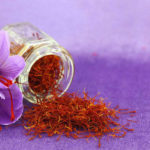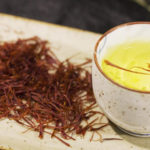Saffron, also known as saffron crocus stigma, has gained a lot of attention recently for its incredible benefits in the beauty industry, as well as its potential as an antioxidant and cancer-fighter. This article will uncover everything you need to know about this valuable spice, including its different types, various applications, and the multitude of health benefits it offers.
Learn more about saffron and how to incorporate it into your life by watching this informative video:
[youtube url=”https://www.youtube.com/embed/-ZM7UZQjn5c”]
1 Unveiling the Mystery of Saffron: What is it and What are its Varieties?
 Unraveling the Secrets of Saffron and its Varieties
Unraveling the Secrets of Saffron and its Varieties
What is Saffron?
Saffron is an exotic and precious spice, predominantly cultivated in the Middle East and South Asia. It is highly prized in the culinary world and in traditional medicine due to its exceptional nutritional profile.
In the market, one kilogram of premium dried saffron stigmas can cost anywhere between 300 and 500 million VND (Vietnamese Dong).
The Different Types of Saffron
Saffron is classified into five distinct types, each varying in price and nutritional value:
– Negin: Regarded as the highest grade saffron, Negin consists of meticulously trimmed stigmas. It is considered the finest variety available.
– Sargol: Slightly inferior to Negin, Sargol stigmas are thinner and shorter in stature.
– Pushali: This variety includes the yellow style, resulting in a lower quality compared to the aforementioned types.
– Bunch: Harvested and bundled together, making it challenging to inspect individual stigmas.
– Konji: Consists of the roots trimmed from the premium Negin and Sargol types, offering a more affordable option.
2 How to Spot Authentic Saffron: Differentiating it from Counterfeits
Due to its high market value, saffron is often imitated. Here are five simple ways to ensure you’re getting genuine saffron and avoiding low-quality or fake products:
Method 1: Examine the color carefully. Authentic saffron exhibits a deep, rich amber hue without any tiny white spots on the stigmas.
Method 2: Place a stigma on your tongue. If it tastes sweet, it is definitely a counterfeit product. Genuine saffron has a bitter taste.
Method 3: Real saffron has a unique fragrance resembling a blend of dried grass and honey. Avoid purchasing saffron that lacks this distinct aroma or has an overpowering honey scent.
Method 4: Soak the saffron in cold water for 10-15 minutes. High-quality saffron will gradually release a beautiful golden-yellow color, similar to turmeric. Fake saffron, on the other hand, will instantly change the color of the water. Additionally, genuine saffron retains its shape and color even after prolonged soaking, while imitations tend to disintegrate.
Method 5: Combine saffron with baking soda and add a few drops of water. If the mixture turns yellow, it is genuine saffron; if it turns reddish-orange, it is likely a counterfeit product.
3 The High Price of Saffron: Why is it so Expensive?

Referred to as the “Red Gold of Iran,” saffron is an expensive spice and medicinal herb. It is meticulously harvested from crocus flowers that bloom only once a year for a brief period, and each flower yields a mere three stigmas. It takes approximately 150,000 to 200,000 flowers to produce just one kilogram of saffron, making it a labor-intensive and time-consuming process.
Additionally, the delicate task of harvesting saffron flowers is done entirely by hand to ensure the utmost quality.

In Iran, the crocus flowers bloom for a few fleeting weeks in early spring. Skilled artisans carefully hand-pick the flowers in the early morning hours. After plucking the stigmas, they are meticulously dried, resulting in a significant reduction in weight to one-third of their original fresh weight. The drying process must be precisely controlled, as overly dry stigmas lose their delicate flavor and quality.
4 The Many Health Benefits of Saffron
Saffron’s Superb Health Benefits
– Boosts Memory: Saffron contains crocin and crocetin, powerful compounds that enhance memory function and cognitive performance.
– Natural Anti-Depressant: Research suggests that saffron possesses antidepressant properties comparable to low-dose fluoxetine or imipramine, offering a natural approach to managing depression.
– Regulates Menstrual Cycles: Saffron has been found to help regulate menstrual cycles and alleviate associated symptoms.
– Promotes Cardiovascular Health: Saffron may play a role in preventing cardiovascular diseases, supporting heart health.
– Rich in Essential Minerals: Saffron is a natural source of vital minerals such as manganese, iron, potassium, and magnesium, which contribute to overall health and well-being.
Saffron’s Beauty Benefits: Enhancing Your Natural Radiance

– Anti-Aging Properties: Saffron is abundant in provitamin A, including retinal, retinol, retinoic acid, and carotenoids, which work together to reduce the signs of aging, enhance skin elasticity, and promote a youthful glow.
– Skin Restoration and Oil Control: The B-complex vitamins present in saffron, such as B1, B2, B3, B6, and B9, help restore skin health, balance oil production, and treat acne.
– Skin Whitening and Brightening: The presence of vitamin C in saffron stimulates collagen production, reduces skin pigmentation, and evens out skin tone, resulting in a brighter and more radiant complexion.
5 Exploring the Various Ways to Use Saffron

1. Consumable Forms: Incorporating Saffron into Your Diet
Saffron tea is an excellent way to harness its benefits, as it can help treat menstrual disorders, reduce stress and fatigue, stabilize blood pressure, improve blood circulation, and even contribute to cancer prevention.
– Saffron Tea: Infuse 3-5 saffron stigmas in a liter of boiling water for 10-20 minutes to extract their nutrients.
– Milk Infusion: Soak 2-3 saffron stigmas in warm milk until it takes on a delicate yellow hue.
– Enhance the flavor of your saffron tea by sweetening it with honey or blending it with fruit juices, adding extra vitamins and minerals to your drink.
2. Facial Masks: Enhancing Your Skincare Routine
Facial masks are an essential step in any beauty routine. Choose the saffron facial mask that best suits your skin type:
Saffron and Aloeswood Powder Mask: Targeting Acne and Dark Spots
Combine 5-7 saffron stigmas, one teaspoon of aloeswood powder, and two teaspoons of unsweetened milk. Apply the mixture to your face for 20 minutes, then rinse with water.
Saffron and Fresh Milk Mask: Revitalizing Dry and Dull Skin
Soak 5-7 saffron stigmas in one teaspoon of unsweetened milk for 2-3 hours. Apply the infused milk to your face and gently massage for 10 minutes. Rinse with water.
Lotion Mask with Saffron:
In a clean glass jar, add a small amount of liquid lotion for better absorption, 7 compressed sheet masks (Miniso, Muji, or similar), and 10 saffron stigmas. Soak the masks in the lotion for about 10 minutes. If needed, add more lotion to completely cover the masks. Finally, store the jar in the refrigerator overnight before use.
Saffron and Rice Bran Mask:
Mix 5-7 saffron stigmas, one teaspoon of plain yogurt, one teaspoon of rice bran, and a pinch of salt. Apply the paste evenly to your face and leave it on for 15-20 minutes before rinsing with water.
6 Important Precautions when Using Saffron

Recommended Saffron Dosage
– For individuals consuming saffron for general well-being and beauty benefits, a daily intake of 15mg is recommended.
– For those experiencing mild to moderate depression, a dosage of 30mg per day, divided into two doses, is advised.
– The safe upper limit for saffron consumption is 1.5 grams per day. Exceeding this amount may lead to adverse effects.
– It is important to note that consuming 20 grams or more of saffron per day can be fatal.
Signs of Saffron Overdose
– Mild Symptoms: Dizziness, vomiting, and diarrhea. Other symptoms may vary depending on individual factors.
– Severe Symptoms: Numbness in the hands and feet, itching all over the body, and bleeding from the eyelids, lips, or nose.
Age Considerations for Saffron Consumption
While saffron is suitable for all ages due to its health benefits, certain individuals should exercise caution:
– Pregnant women, especially during the first trimester.
– Women during their menstrual period, as it may interfere with hormone levels.
– Individuals with low blood pressure, as saffron can act as a vasodilator.
– People with a history of allergies to plants such as lolium, Olea, and salsola should consult a healthcare professional before consuming saffron.
Proper Saffron Storage
– Store saffron in clean, airtight containers that are odorless to prevent contamination.
– Use tweezers to handle saffron threads to maintain hygiene and avoid waste.
– Keep saffron in a cool, dry place, away from direct sunlight.
– Do not refrigerate saffron, as condensation can affect its quality.
Saffron is an incredibly valuable herb with a multitude of health and beauty benefits. However, due to its high price, it is essential to purchase it from reputable sources to ensure its quality and authenticity. Saffron also makes a thoughtful and unique gift for loved ones.
For more interesting and useful information, visit:
Unraveling the Secrets of Saffron: Identifying Authentic Saffron and Understanding its Cost
Are you intrigued by saffron pistils and their myriad benefits? From enhancing beauty to boosting health when soaked in filtered water and sweetened with honey, saffron offers a wealth of advantages. In the Tips in the Kitchen section of XANH Electric Appliances, you can discover everything you need to know about distinguishing real saffron from imitations, understanding its cost, and more!
“The Ultimate Guide to Drinking Saffron Threads for Glowing Skin and Vitality”
Saffron, or the precious ‘red gold’, has long been revered for its divine powers in promoting health and beauty. But how do you unlock its full potential? Discover the ultimate guide to consuming saffron correctly, sufficiently, and effectively – revealing the secrets to enhancing your well-being and unlocking your radiant self.
Price and Availability of Saffron: What to Know
Are you seeking top quality saffron with unbeatable prices? Look no further – we have the best saffron on the market! Known for its immense benefits for human beauty and health, saffron is a miracle in the form of a spice. Unfortunately, there is a widespread problem of counterfeit and low-quality saffron. We ensure that the saffron we offer is of the finest quality and lowest prices.
Identifying Authentic Saffron and Understanding its Cost
Are you interested in learning more about saffron pistils? From their beauty benefits to their numerous health benefits when soaked in filtered water and stirred with honey, you can get all the information you need in the Tips in the Kitchen section of XANH Electric Appliances! Here, you can find out how to tell the difference between real and fake saffron, what the cost is, and even more!

































